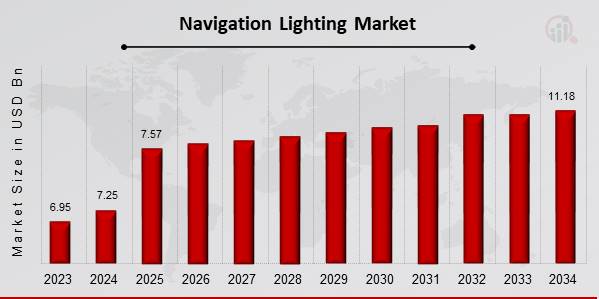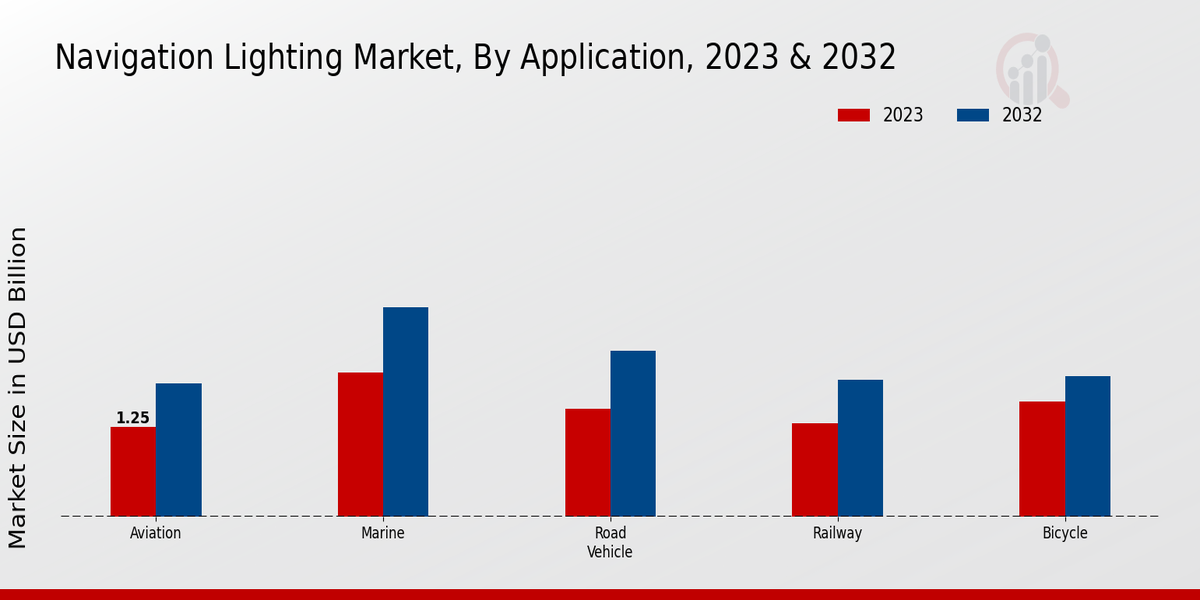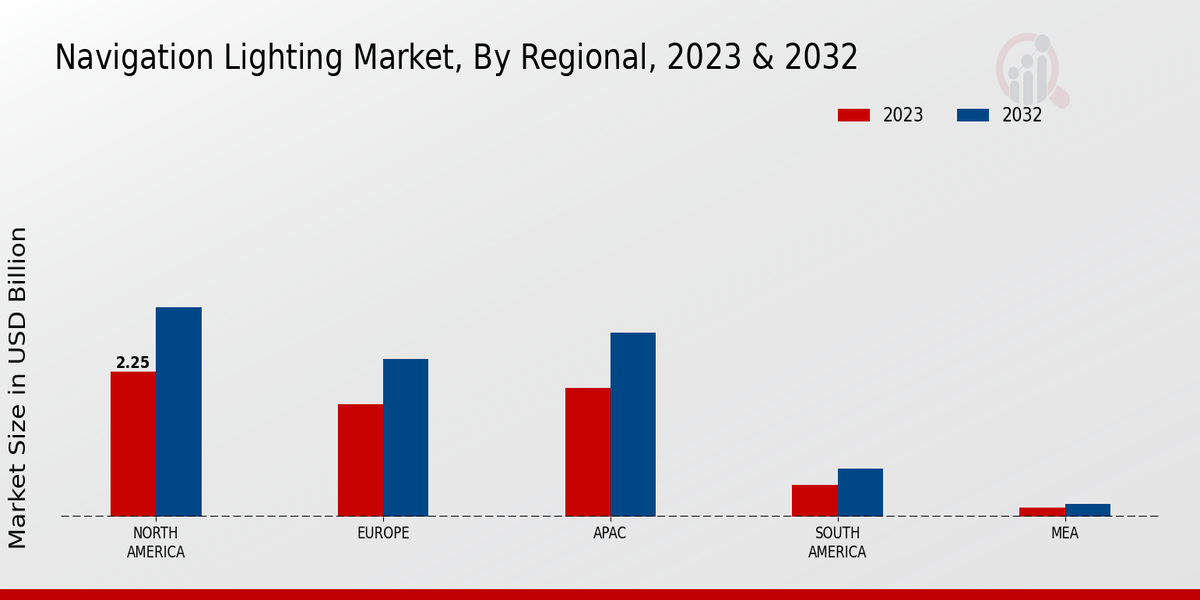Global Navigation Lighting Market Overview
Navigation Lighting Market Size was estimated at 7.25 (USD Billion) in 2024. The Navigation Lighting Market is expected to grow from 7.57 (USD Billion) in 2025 to 11.18 (USD Billion) by 2034. The Navigation Lighting Market CAGR (growth rate) is expected to be around 4.40% during the forecast period (2025 - 2034).

Source Primary Research, Secondary Research, MRFR Database and Analyst Review
Key Navigation Lighting Market Trends Highlighted
The Navigation Lighting Market is influenced by several key market drivers. One major factor is the growing emphasis on safety in aviation and marine industries, leading to increased adoption of advanced navigation lighting solutions.
Technological advancements, such as the integration of LED lighting systems, enhance visibility and energy efficiency, further driving market growth. In addition, the regulatory landscape and international standards for maritime and air navigation safety create a conducive environment for the expansion of this market.
As industries aim to modernize their operations, the demand for reliable and efficient navigation lighting systems continues to rise.
Opportunities in the Navigation Lighting Market are abundant, particularly in emerging economies where infrastructure development is accelerating. As ports and airports expand, the need for effective navigation lighting becomes critical to ensure safe operations.
Moreover, there is potential for innovation in smart lighting technologies, which can improve energy management and reduce operational costs. Collaborations between industry players and investments in research and development could lead to new products that meet the evolving needs of the market.
Expanding application areas, such as renewable energy projects and offshore installations, also present significant opportunities for growth.
Trends observed in recent times indicate a shift towards more environmentally friendly and energy-efficient lighting solutions. The use of solar-powered navigation lights is gaining traction due to their low operating costs and ease of installation.
Moreover, the rise of automation and smart technologies is ushering in a new era for navigation lighting, with more systems becoming interconnected and data-driven. This transformation aligns with the broader trend towards sustainability in various sectors, making navigation lighting an integral part of green initiatives.
As industries adapt to these changes, the Navigation Lighting Market is poised for continued evolution, reflecting broader technological and environmental trends.
Navigation Lighting Market Drivers
Increasing Demand for Aviation Safety Standards
The Navigation Lighting Market is significantly driven by the rising emphasis on aviation safety standards. With an increasing number of aircraft movements globally, regulatory authorities and aviation bodies are implementing stricter regulations and guidelines to ensure the safety of air travel.
This includes the need for effective and reliable navigation lighting systems that enhance visibility during take-offs, landings, and while on the ground.
As the aviation sector continues to grow, the demand for advanced navigation lighting technologies is expected to escalate. Additionally, emerging markets are witnessing an increase in air traffic, necessitating an upgrade in airport infrastructure, including navigation lighting systems.
The integration of technology such as LED lighting and smart control systems not only improves performance but also conserves energy, thus responding to the growing demand for sustainable aviation solutions.
As safety remains paramount, the aviation community is investing in navigation lighting, aiming to enhance overall operational safety and efficiency, which directly influences the Navigation Lighting Market.
Additionally, with the gradual recovery from the impacts of disruptions in travel due to past crises, there is a notable rebound in the aviation sector, further accelerating the market growth.
The introduction of advanced aircraft compatible with modern navigation lights also serves as a catalyst for enhancing safety measures in aviation, ensuring that lighting systems remain compliant and facilitate optimal operational conditions.
Technological Advancements in Navigation Lighting
Technological advancements are a key driver for the growth of the Navigation Lighting Market. With innovations such as LED technology, smart lighting systems, and automation, navigation lighting has become more efficient, cost-effective, and environmentally friendly.
LED lights, for instance, offer longer lifespans and lower energy consumption compared to traditional lighting options. As a result, airlines and airports are increasingly adopting these modern technologies to reduce operational costs and improve the reliability of their navigation systems.
Moreover, the integration of IoT and smart controls into navigation lighting solutions provides enhanced monitoring and management capabilities, contributing to overall safety and efficiency in aviation operations.
Expansion of the Transportation Sector
The expansion of the transportation sector, particularly the aviation and maritime industries, is significantly driving demand for navigation lighting.
As trade routes become more robust and international travel increases, there is an urgent need for effective navigation systems to support this growth. Effectively illuminated airports and seaports are essential to ensure safety, reduce accidents, and manage traffic effectively.
This growth is supported by increasing investments in infrastructure, leading to more installations of navigation lighting systems across various transport hubs, contributing to the overall growth of the Navigation Lighting Market.
Navigation Lighting Market Segment Insights
Navigation Lighting Market Application Insights
The Navigation Lighting Market is poised for substantial growth as it encompasses various applications critical to safety and efficiency across different modes of transportation. The growing market is driven by the increasing need for reliable navigation lights in various segments such as Aviation, Marine, Road Vehicle, Railway, and Bicycle.
Specifically, the Aviation sector was valued at 1.25 USD Billion in 2023 and is projected to grow to 1.85 USD Billion by 2032, making it a significant contributor to the overall market. The Marine segment held a major share with a valuation of 2.0 USD Billion in 2023 and is expected to rise to 2.9 USD Billion by 2032, emphasizing its importance in ensuring safety on waterways.
Additionally, the Road Vehicle segment valued at 1.5 USD Billion in 2023 and anticipated to increase to 2.3 USD Billion by 2032 highlights the requirement for enhanced visibility and safety on roads. The Railway sector, while smaller, also played a crucial role, valued at 1.3 USD Billion in 2023 and projected to rise to 1.9 USD Billion, ensuring the safety of train operations.
Lastly, the Bicycle segment, valued at 1.6 USD Billion in 2023 and reaching 1.95 USD Billion by 2032, shows growth potential as urban cycling becomes more popular, further driving the need for navigation lighting solutions to enhance rider safety.
The majority holding in the Navigation Lighting Market revenue is largely influenced by growth drivers such as increasing safety regulations, technological advancements, and the rising trend of smart transportation solutions.
However, challenges such as high manufacturing costs and regulatory hurdles may impact overall market growth. Thus, the Navigation Lighting Market segmentation underscores the importance of tailored lighting solutions across various transportation modes, presenting opportunities for innovation and expansion in this critical industry.

Source Primary Research, Secondary Research, MRFR Database and Analyst Review
Navigation Lighting Market Technology Insights
The market encompasses various technologies, each contributing to the overall landscape in distinctive ways. LED technology is recognized for its energy efficiency and longevity, making it a major driving force in the market and addressing the need for sustainable solutions.
Incandescent lighting, though less energy-efficient, offers a warm light quality that remains favored in certain applications. Halogen lights, known for their brightness and consistent color temperature, are significant for specific navigation purposes.
Additionally, Xenon lighting is valued for its excellent color rendering, often utilized in more demanding environments. Fluorescent lighting, while less common, contributes to energy savings in applications where continuous lighting is required.
The Navigation Lighting Market revenue reflects an ongoing transition toward more advanced and efficient lighting technologies, fostering opportunities for innovation and enhancement in safety and operational efficiency.
The market faces challenges from evolving regulations and the need for maintenance of existing systems, but the continued push for improved navigation solutions presents significant growth opportunities.
Navigation Lighting Market End Use Insights
The end-user segment is crucial as it comprises various applications, namely Commercial, Residential, and Industrial, each contributing significantly to market growth. The commercial sector dominates due to the increasing demand for effective navigation solutions in urban settings, driven by rising commercial activities and urbanization.
In contrast, the residential segment witnesses steady growth owing to heightened awareness regarding safety and energy efficiency in home lighting.
The industrial segment plays a significant role in ensuring safety compliance in manufacturing and logistics operations. Together, these segments reflect the diverse applications of navigation lighting, highlighting trends such as sustainability and technological advancements.
Navigation Lighting Market statistics further reveal that consistent advancements in LED technology significantly enhance product efficiency and longevity, catering to varying customer needs.
The overall market growth is propelled by these trends, while challenges surrounding regulations and maintenance practices present opportunities for innovation in design and application across all segments.
Navigation Lighting Market Mounting Type Insights
Among the various mounting types utilized in navigation lighting, Wall Mounted, Ceiling Mounted, and Pole Mounted options have gained substantial traction. Wall Mounted fixtures are particularly favored in urban settings, ensuring compliance with safety regulations and enhancing visibility.
Ceiling Mounted lighting offers versatility and is commonly found in spaces where unobtrusive fixtures are needed, contributing to overall aesthetic appeal. Meanwhile, Pole Mounted lights dominate in outdoor applications, providing essential illumination for navigation in large open spaces.
The mounting type segment is vital due to its direct impact on efficiency and visibility in navigation systems, thus driving the overall Navigation Lighting Market growth.
The data shows an increasing trend towards adopting advanced mounting solutions, which underscores the importance of market dynamics in innovation and consumer preferences while ensuring safety and compliance in navigation environments.
Navigation Lighting Market statistics reveal that the evolution of these mounting systems significantly influences operational efficiency in navigation practices globally.
Navigation Lighting Market Regional Insights
The Navigation Lighting Market is experiencing steady growth across various regions, reflecting significant demand for navigation lighting solutions. In 2023, the North American market was valued at 2.25 USD Billion, which showcases its majority holding in the overall market, driven by advanced maritime and aviation sectors.
Europe followed closely with a market valuation of 1.75 USD Billion, highlighting its importance due to strict regulatory frameworks and safety standards in navigation. The APAC region, valued at 2.0 USD Billion, showed emerging opportunities, particularly in shipping and trade, which contribute to its growing prominence.
South America, valued at 0.5 USD Billion, had a smaller yet noteworthy presence in the Navigation Lighting Market as the region seeks to enhance its navigation infrastructure. The Middle East and Africa (MEA), valued at 0.15 USD Billion, represented the developing markets within the navigation lighting sector, characterized by limited adoption but potential growth opportunities.
Overall, the regional segmentation illustrates varying market dynamics and growth drivers that contribute to the comprehensive insights and statistics of the Navigation Lighting Market.

Source Primary Research, Secondary Research, MRFR Database and Analyst Review
Navigation Lighting Market Key Players and Competitive Insights
The Navigation Lighting Market has demonstrated remarkable growth and innovation, largely driven by the increasing demand for safety and navigation solutions across various sectors.
This market encompasses a wide range of lighting products specific to navigation, catering to maritime, aviation, and terrestrial applications. Competitive dynamics within this market are influenced by technological advancements, regulatory frameworks, and the growing trend toward sustainability in lighting solutions.
As organizations strive to enhance visibility and safety standards, manufacturers are continually evolving their product offerings to meet rigorous demands while adhering to environmental guidelines. The interplay of established players and emerging participants in this sphere creates a diverse landscape characterized by a variety of strategies and approaches to market penetration.
Lutron Electronics has positioned itself as a formidable player in the Navigation Lighting Market through its innovative approach and commitment to quality. Known for its advanced lighting control systems, Lutron Electronics leverages its expertise in automation to enhance navigation lighting solutions that address the specific needs of the market.
The company emphasizes energy efficiency and user-friendly interfaces, ensuring that its products not only improve safety standards but also align with modern sustainability goals. Lutron’s strong focus on research and development allows it to stay ahead of trends and anticipate customer needs, leading to the introduction of cutting-edge technology.
The brand’s reputation for reliable performance and product longevity has established a solid foothold in the Navigation Lighting Market.
Signify, a key contender in the Navigation Lighting Market focuses on harnessing the power of connected lighting to enhance visibility and safety in navigation applications. The company's innovative product line includes smart lighting systems that integrate seamlessly with various navigation technologies, thereby enhancing operational efficiency.
Signify's emphasis on sustainability aligns well with the increasing demand for eco-friendly solutions, positioning it favorably against competitors. By prioritizing research into emerging technologies, such as LED and IoT-based solutions, Signify works to set standards in the industry, ensuring that its navigation lighting products are not only effective but also environmentally responsible.
The strategic collaborations and partnerships that Signify engages in further amplify its market presence, allowing it to reach a wider audience and reinforce its position as a leader in the Navigation Lighting Market.
Key Companies in the Navigation Lighting Market Include
Navigation Lighting Market Developments
In recent months, the Navigation Lighting Market has seen significant developments, particularly with advancements in LED technology and sustainable energy solutions. Companies like Signify and Cree continue to innovate by enhancing the energy efficiency and lifespan of their navigation lighting products, aligning with sustainability trends.
Legrand and Eaton are focusing on expanding their smart lighting solutions, which integrate IoT capabilities, catering to the growing demand for intelligent infrastructure. Additionally, Philips Lighting has been actively involved in smart city projects, promoting advanced navigation lighting systems that improve visibility and safety in urban areas.
In terms of mergers and acquisitions, Hubbard Lighting recently announced its acquisition of a smaller lighting firm, aiming to bolster its product offerings and market share. Likewise, GE Lighting has been pursuing partnerships to enhance its technological capabilities in the navigation lighting sector.
As these companies enhance their products and explore strategic collaborations, the market is experiencing a notable increase in valuation, driven by heightened investment in infrastructure and smart technology. This growing focus on innovation and efficiency is expected to positively impact the Navigation Lighting Market's future trajectory, reflecting a robust demand for advanced lighting solutions.
Navigation Lighting Market Segmentation Insights
| Report Attribute/Metric |
Details |
| Market Size 2024 |
7.25(USD Billion) |
| Market Size 2025 |
7.57(USD Billion) |
| Market Size 2034 |
11.18(USD Billion) |
| Compound Annual Growth Rate (CAGR) |
4.40% (2025 - 2034) |
| Report Coverage |
Revenue Forecast, Competitive Landscape, Growth Factors, and Trends |
| Base Year |
2024 |
| Market Forecast Period |
2025 - 2034 |
| Historical Data |
2021 - 2024 |
| Market Forecast Units |
USD Billion |
| Key Companies Profiled |
Lutron Electronics, Signify, Hubbell Lighting, Philips Lighting, Advanced Lighting Technologies, Norsk Solar, Legrand, Cree, Eaton, RAB Lighting, Schneider Electric, Acuity Brands, GE Lighting, Osram, Visionaire Lighting |
| Segments Covered |
Application, Technology, End Use, Mounting Type, Regional |
| Key Market Opportunities |
Technological advancements in LED, Increased demand for safety regulations, Expansion in maritime tourism, Growth in drone navigation systems, and Rising investment in infrastructure development |
| Key Market Dynamics |
Technological advancements in lighting, Rising demand for marine safety, Increasing commercial shipping activities, Government regulations and standards, and Growth of the aviation sector |
| Countries Covered |
North America, Europe, APAC, South America, MEA |
Frequently Asked Questions (FAQ) :
The Navigation Lighting Market is expected to be valued at 11.18 USD Billion by 2034.
The expected CAGR for the Navigation Lighting Market from 2024 to 2032 is 4.40%.
The Marine application held the largest market value at 2.0 USD Billion in 2023.
In 2034, the market size for Navigation Lighting in North America is projected to be 3.25 USD Billion.
Key players in the Navigation Lighting Market include Lutron Electronics, Signify, Hubbell Lighting, and Philips Lighting, among others.
The market size for the Road Vehicle application is expected to reach 2.3 USD Billion by 2034.
The Railway application is projected to reach a market size of 1.9 USD Billion by 2034.
The APAC region is expected to grow to a market size of 2.85 USD Billion by 2034.
The Bicycle application held a market value of 1.6 USD Billion in 2023.
The MEA region is expected to have a market size of 0.2 USD Billion by 2034.

















